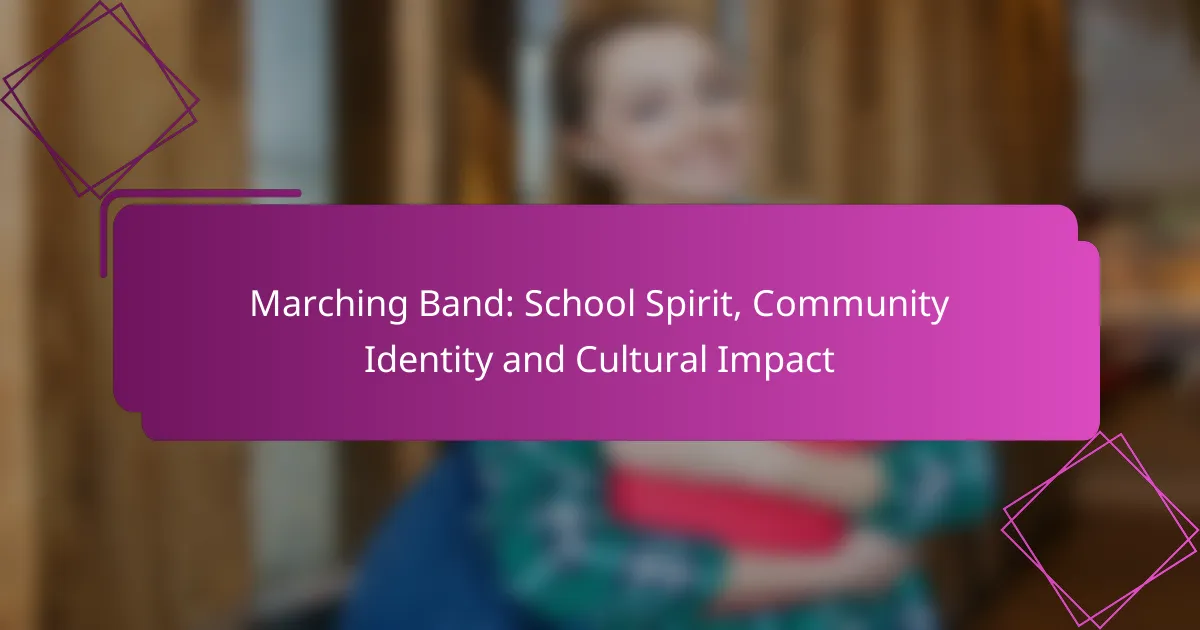Marching bands play a vital role in enhancing school spirit and fostering community identity across the United States. By creating an energetic atmosphere at events, they unite students, faculty, and local residents, while also reflecting and promoting regional culture and traditions. Through their performances, marching bands not only inspire pride and enthusiasm but also strengthen the bonds within communities, making them an integral part of the cultural landscape.
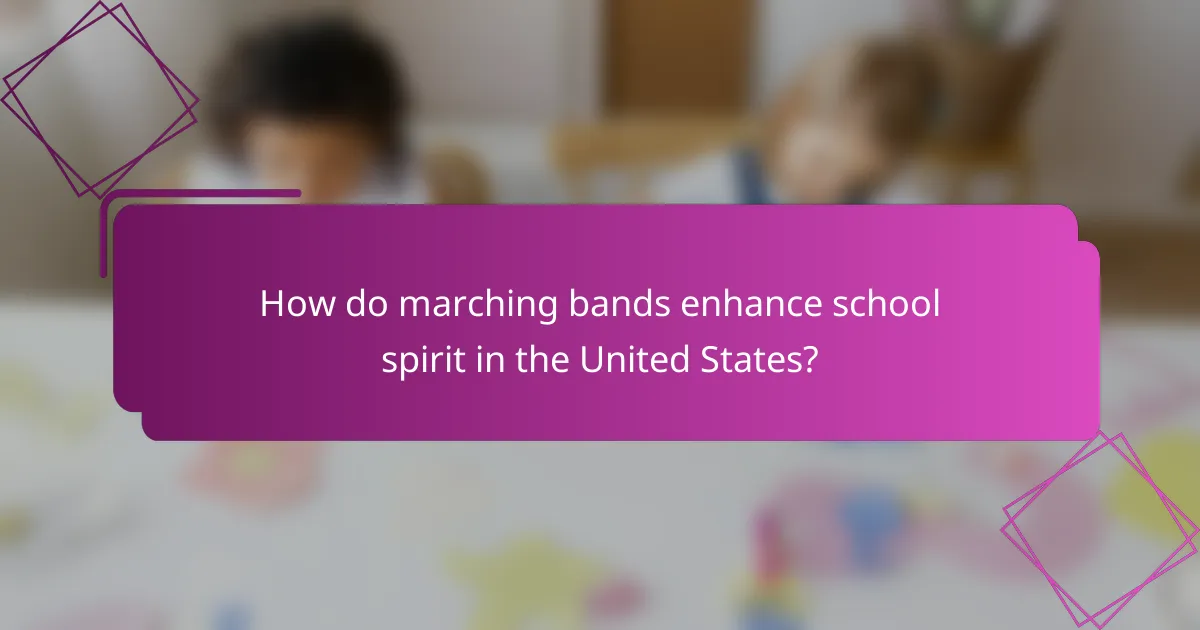
How do marching bands enhance school spirit in the United States?
Marching bands significantly enhance school spirit in the United States by fostering pride and unity among students, faculty, and the community. They create a vibrant atmosphere at sporting events and school functions, encouraging participation and enthusiasm.
Boosting student morale
Marching bands play a crucial role in boosting student morale by providing a platform for students to showcase their talents and work collaboratively. The shared experience of rehearsals and performances helps build camaraderie, which can uplift spirits and create a positive school environment.
Participation in a marching band can also lead to increased self-esteem, as students gain confidence through mastering their instruments and performing in front of audiences. This sense of achievement can motivate students to engage more actively in other school activities.
Creating a sense of belonging
Marching bands foster a strong sense of belonging among students by forming tight-knit communities within the larger school environment. Members often develop lasting friendships, which can enhance their overall school experience and encourage loyalty to their school.
Through participation in band events, students feel connected to a larger tradition, reinforcing their identity as part of the school. This connection can be particularly impactful for new students or those who may feel isolated, as it provides them with a supportive network.
Engaging alumni and community
Marching bands engage alumni and the wider community by creating opportunities for connection and participation in school events. Alumni often return to support their former band, fostering a sense of pride and continuity that enhances school spirit.
Community events, such as parades and competitions, allow marching bands to represent their schools while also drawing in local support. This engagement can lead to increased attendance at school events and greater community investment in school programs.
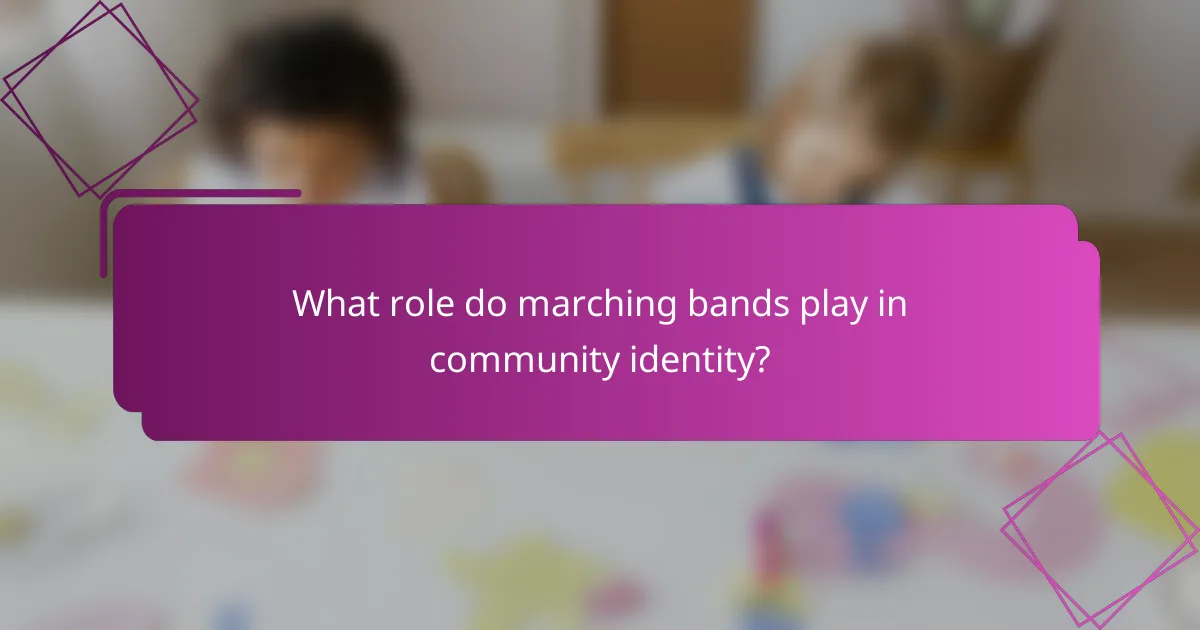
What role do marching bands play in community identity?
Marching bands significantly contribute to community identity by embodying local culture, fostering pride, and creating a sense of belonging among residents. They serve as a unifying force, bringing together diverse groups and promoting local traditions and events.
Fostering local pride
Marching bands often serve as a source of local pride, showcasing the unique characteristics and traditions of a community. Through performances at parades, football games, and festivals, they highlight the spirit and values of the area, reinforcing a collective identity.
For example, a marching band may incorporate local history or folklore into their routines, allowing residents to connect with their heritage. This connection can inspire community members to engage more actively in local initiatives and support local schools.
Uniting diverse groups
Marching bands have the ability to unite individuals from various backgrounds, creating a shared experience that transcends differences. Members often come together from different schools, neighborhoods, and cultures, fostering friendships and collaboration.
Participation in a marching band encourages teamwork and communication, as members must work together to achieve a common goal. This unity can lead to stronger community ties and a greater sense of belonging among residents.
Promoting local events and traditions
Marching bands play a crucial role in promoting local events and traditions by performing at key community gatherings. Their presence at events such as parades, festivals, and sporting events helps to draw attention and increase participation.
Additionally, bands often incorporate local music and themes into their performances, celebrating regional culture and history. This not only entertains but also educates attendees about the community’s unique identity and traditions.
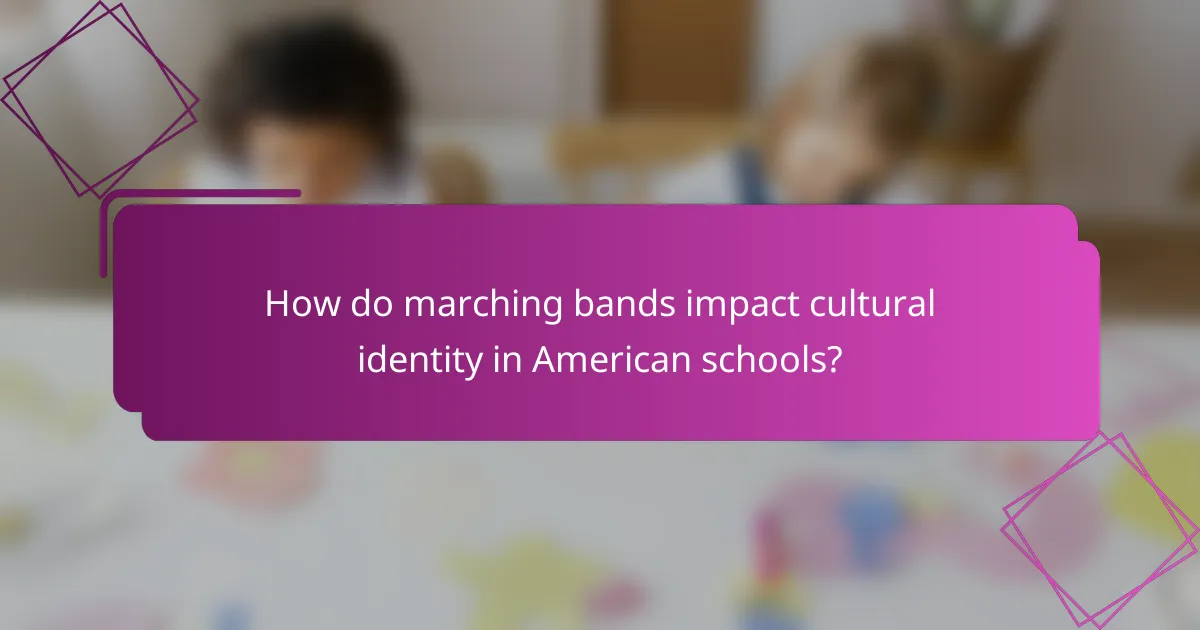
How do marching bands impact cultural identity in American schools?
Marching bands significantly influence cultural identity in American schools by serving as a reflection of local traditions and values. They foster a sense of belonging and pride among students, while also connecting communities through shared musical experiences.
Reflecting regional musical styles
Marching bands often incorporate regional musical styles that resonate with local culture. For instance, bands in the Southern United States may feature jazz and blues influences, while those in the Midwest might emphasize folk and country music. This regional representation helps students connect with their heritage and fosters a sense of pride in their community.
Additionally, the choice of music played during performances can highlight local historical events or figures, further embedding the band within the cultural narrative of the area. Schools can enhance this connection by selecting pieces that celebrate local traditions during competitions and parades.
Incorporating diverse cultural influences
Marching bands frequently integrate diverse cultural influences, reflecting the multicultural makeup of American society. This can include incorporating music from various ethnic backgrounds, such as Latin, African, or Asian musical traditions. By doing so, bands not only educate members about different cultures but also promote inclusivity and respect among students.
For example, a band might perform a piece that combines traditional Native American rhythms with contemporary pop music, showcasing the richness of cultural diversity. This approach can help students appreciate the value of different cultural expressions and foster a more inclusive school environment.
Encouraging cultural exchange
Marching bands serve as a platform for cultural exchange, allowing students to learn from one another and share their unique backgrounds. Through collaborations with other schools or community groups, bands can participate in joint performances that celebrate various cultural heritages. This interaction promotes understanding and appreciation among students from different backgrounds.
Schools can facilitate cultural exchange by organizing events such as multicultural festivals or joint concerts, where marching bands showcase their diverse repertoires. These activities not only enrich the students’ musical experiences but also strengthen community ties and promote a broader understanding of cultural identity.
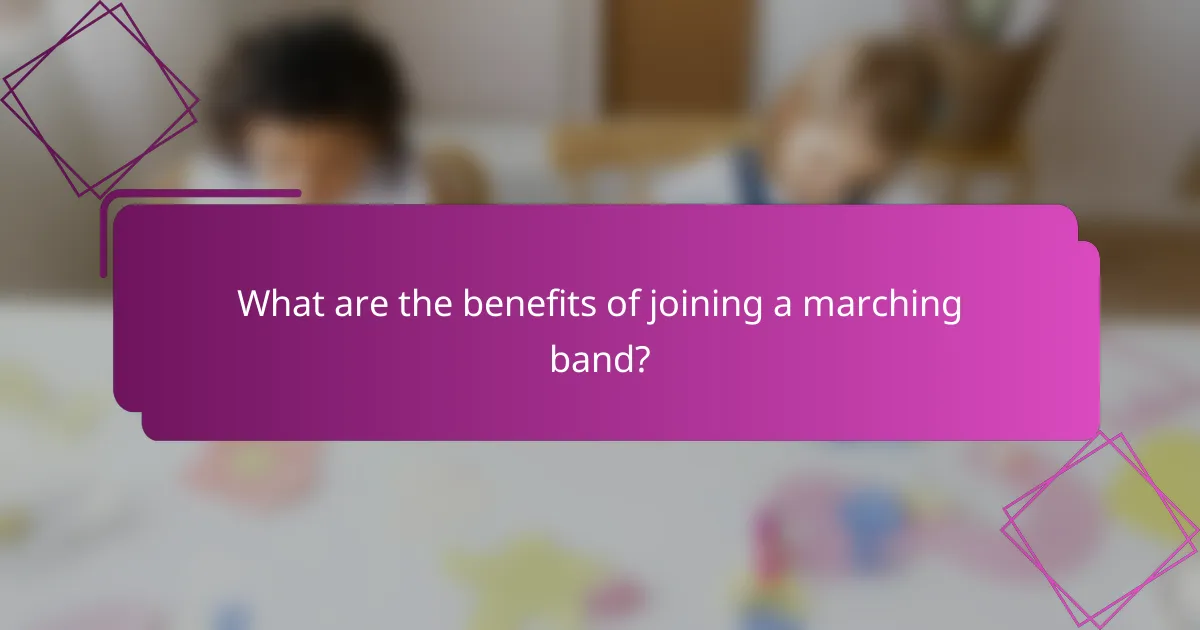
What are the benefits of joining a marching band?
Joining a marching band offers numerous benefits, including the development of teamwork skills, enhancement of musical talent, and the opportunity to build lifelong friendships. These advantages contribute to personal growth and a sense of community within the band.
Developing teamwork skills
Marching band requires members to work closely together, fostering strong teamwork skills. Musicians must synchronize their movements and sounds, which teaches them the importance of collaboration and communication.
Participating in group practices and performances helps students learn how to support one another, share responsibilities, and achieve common goals. This experience can translate into better teamwork in academic and professional settings later in life.
Enhancing musical talent
Joining a marching band significantly enhances musical talent through regular practice and performance. Members receive instruction from experienced directors and often participate in competitions, which pushes them to improve their skills.
Additionally, the diverse repertoire of music played in marching bands allows students to explore different styles and techniques, broadening their musical knowledge. This can lead to greater proficiency in their primary instrument and a deeper appreciation for music.
Building lifelong friendships
Marching band provides a unique environment for building lifelong friendships. The shared experiences of rehearsals, performances, and competitions create strong bonds among members.
These friendships often extend beyond the band, as students support each other in academics and personal challenges. Many band members find that the connections they make during their time in the band last well into adulthood, creating a lasting sense of community.
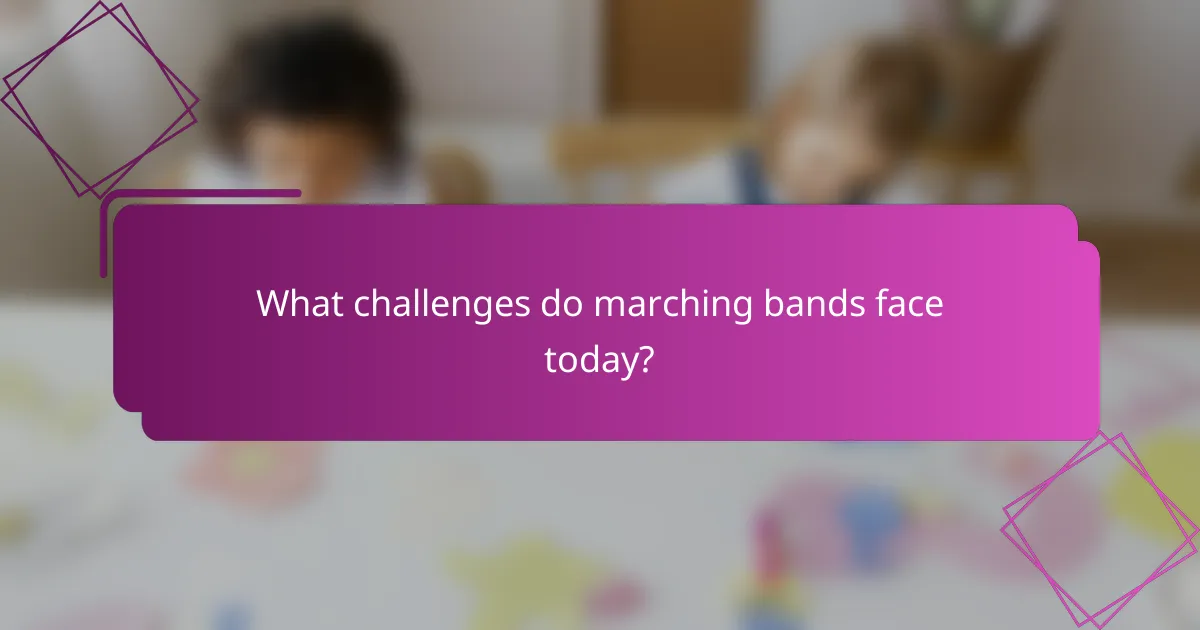
What challenges do marching bands face today?
Marching bands today encounter various challenges that impact their performance and sustainability. Key issues include funding and resource limitations, balancing academic commitments, and adapting to the evolving interests of students.
Funding and resource limitations
Many marching bands struggle with securing adequate funding to cover essential expenses such as uniforms, instruments, and travel costs. Schools often allocate limited budgets, making it difficult for bands to maintain high standards and participate in competitions.
To address funding challenges, bands can explore multiple revenue sources, including sponsorships from local businesses, fundraising events, and grants from arts organizations. Engaging the community in these efforts can strengthen support and increase financial resources.
Balancing academic and extracurricular commitments
Students involved in marching bands often face the challenge of juggling their academic responsibilities with the demands of rehearsals and performances. This balancing act can lead to stress and time management issues, especially during peak academic periods like exams.
Encouraging open communication between band directors, students, and parents can help create a supportive environment. Establishing a clear schedule that accommodates both academic and band commitments can also alleviate pressure on students.
Adapting to changing student interests
As student interests evolve, marching bands must adapt to remain relevant and appealing. With the rise of digital music and other extracurricular activities, attracting and retaining members can be challenging.
To engage students, bands can incorporate contemporary music styles, collaborate with other school programs, and highlight the social aspects of participation. Offering diverse performance opportunities can also attract a wider range of students, ensuring the longevity of the band program.
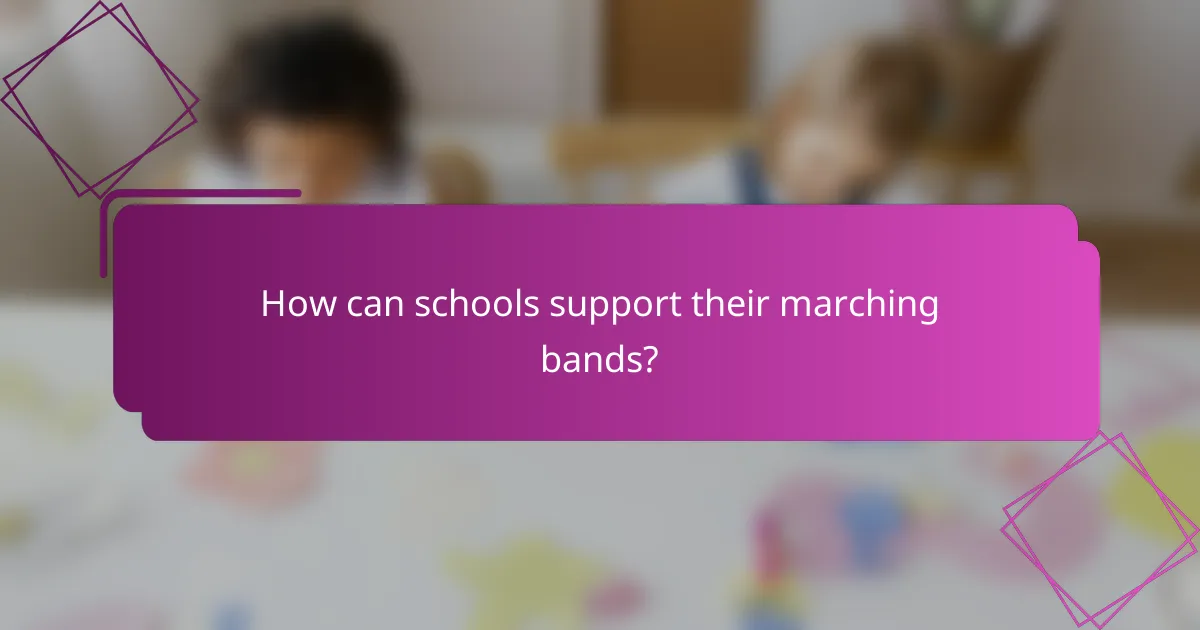
How can schools support their marching bands?
Schools can support their marching bands by increasing funding, providing dedicated practice spaces, and encouraging community involvement. These actions help enhance the band’s performance quality and strengthen its role in school spirit and community identity.
Increasing funding opportunities
To effectively support marching bands, schools should seek diverse funding sources. This can include grants from arts foundations, sponsorships from local businesses, and fundraising events organized by parents and students.
Establishing a budget that allocates funds specifically for band needs, such as uniforms, instruments, and travel expenses, is crucial. Schools might consider setting a target of at least a few thousand dollars annually to ensure adequate resources.
Providing dedicated practice spaces
Having a dedicated practice space is essential for marching bands to rehearse effectively. Schools should identify suitable areas, such as gymnasiums or outdoor fields, that can accommodate the band’s size and equipment.
Additionally, scheduling regular practice times that do not conflict with other school activities can enhance consistency and focus. Schools should aim for at least two to three hours of practice per week to maintain skill levels and prepare for performances.
Encouraging community involvement
Community involvement can significantly boost the visibility and support for marching bands. Schools should encourage local businesses and organizations to sponsor events or provide resources, fostering a sense of shared ownership and pride.
Organizing community events, such as parades or concerts, where the marching band can perform will help strengthen ties with local residents. Schools can aim to host at least one major community event each semester to engage audiences and build lasting relationships.
